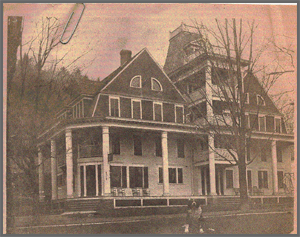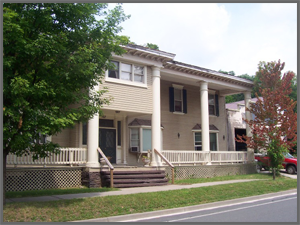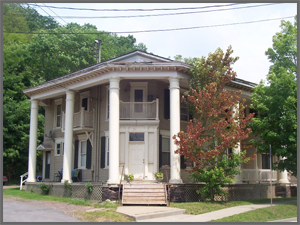| Back to Historical Articles |
The Pillars was Landmark Hotel
(Note: The article was based on an account in the Stamford “Mirror Recorder” by Celin Schoen, written for the nation’s Bicentennial in 1976.)
 The two-story apartment building on Main St. at Cornell Ave. has changed hands many times since it was built more than a century ago. In addition to serving as a hotel, it housed a teen recreation center and village library for many years, and provided the setting for community dinners and bazaars even after the hostelry closed.
The two-story apartment building on Main St. at Cornell Ave. has changed hands many times since it was built more than a century ago. In addition to serving as a hotel, it housed a teen recreation center and village library for many years, and provided the setting for community dinners and bazaars even after the hostelry closed.
The site was occupied by a “public house” from the earliest days of the community, as the first tavern in the village was kept there by George Foote some time before 1795, according to one early account of the village.
A hotel, known as the Green Hotel, was reportedly built on the spot sometime about 1840. Whether its name came from that of an owner or from the color of paint used is not entirely clear, but it apparently burned down not long before the Mansion House – now the Pillars—was built. One of its owners was a Mrs. Mattice, according to a newspaper account, and the owner at the time of the fire was given as a Samuel McMorris.
A report in the Hobart Independent in August, 1906 describing the construction of a new hotel to replace the destroyed structure, states, “Samuel McMorris, who for a time ran the Commercial Hotel here, secured from the people of the village $1,000 in subscription to start the enterprise. The cost increased as the work progressed (!) and difficulty in raising money on mortgages followed. At one time several thousand dollars in mechanics’ and builders’ liens were recorded against the property and it was finally sold at mortgage foreclosure, and passed into the hands of James R. Cowan and Jacob Lawrence of Hobart and Samuel Brice of Oneonta, who in 1906 sold the property to Mrs. W. S. Brazil. Prior to that, the hotel had been leased by an S. W. Utter, who “conducted a first class hostelry,” according to the article in the Independent. When Mr. McMorris saw the load was too great for him, he left town. “Several mechanics lost heavily for materials furnished and work done on the property.” (The building was later reported to have cost $12,000 to construct.) Price was $7,000
An interesting footnote to this account is that at the time of purchase, the newspaper, despite “all possible effort,” was unable to learn the name  of the purchaser and could identify her only as a “woman of considerable wealth (who) owns a large and productive farm near Schoharie.” The purchase price was given by the paper as $7,000. Mrs. Brazil owned the hotel, which she renamed the New Hobart Hotel, operating it for 24 years with her daughter, Mrs. Freemeyer. It was then sold to Harry Drake of Oneonta, who also owned an establishment in Stamford at one time.
of the purchaser and could identify her only as a “woman of considerable wealth (who) owns a large and productive farm near Schoharie.” The purchase price was given by the paper as $7,000. Mrs. Brazil owned the hotel, which she renamed the New Hobart Hotel, operating it for 24 years with her daughter, Mrs. Freemeyer. It was then sold to Harry Drake of Oneonta, who also owned an establishment in Stamford at one time.
The hotel changed hands several times after that. Other owners included James Aiken, a Mr. Gregory of Binghamton, then a Mr. Peralto, also of Binghamton, Mr. Brown of Morris, Leon Simmons of Oneonta, and Arthur Seybolt, also of Oneonta. The property was sold again but reverted to Mr. Seybolt by virtue of a mortgage foreclosure. It was later sold to Vincent Martucci of Delhi.
Many residents recall the restaurant on the first floor, and have warm memories of the gala roast beef dinner and dance each New Year’s Eve. Large numbers of former residents returned to join friends, relatives and one-time neighbors for the event. One of the mementos in the collection of Glen Kaufman is a ribbon commemorating the 78th annual supper and dance sponsored by the Hobart Fire Department on Dec. 3, 1966.
Residents also remember when dances were held in Grant’s Opera House. The dance bands came from Albany to Oneonta on the Delaware & Hudson RR, or perhaps from Oneonta itself, and stayed overnight at the hotel. (Grant’s Opera House, incidentally, was the former Methodist Church building, moved across the village to house not only a place of entertainment, but also a meat market. The building later was known as Van Buren’s Hardware, and later as Martin’s hardware.)
The upper two stories of the hotel were destroyed by a fire of unknown origin on May 7, 1941. Firemen from Delhi, Bloomville, Stamford and Grand Gorge aided the Hobart company and succeeded in saving the lower two floors. Damage was estimated at $35,000.
Became Community Center
 The village took over the building and early in 1942 it was rebuilt for use as a community hall. A caption for a photograph in the Mirror Recorder of February 26, 1942 states that “practically every male citizen in the place lends a hand at work of one sort or another in salvaging the large hotel structure for a community hall.” The item adds that contractor A. T. Dibble of Bloomville “found many willing workers who devoted evenings and spare time to work of reconstruction.” A housewarming was held on Monday, March 2.
The village took over the building and early in 1942 it was rebuilt for use as a community hall. A caption for a photograph in the Mirror Recorder of February 26, 1942 states that “practically every male citizen in the place lends a hand at work of one sort or another in salvaging the large hotel structure for a community hall.” The item adds that contractor A. T. Dibble of Bloomville “found many willing workers who devoted evenings and spare time to work of reconstruction.” A housewarming was held on Monday, March 2.
The Civic Club held its meetings there for many years. It also ran a library on the second floor. This library opened on November 30, 1946 with 681 books contributed by 38 different donors. Among those who were active in operating of the library during its early years were Mrs. Edward A. Burke, Mr. Wallace H. Rich and Mrs. Hoyt Swain. The library continued its services to the reading public for ten or 15 years, but the steep stairs discouraged many of the older patrons, and the library finally closed is doors.
A Youth Canteen was also run there for many years, providing not only hot dogs and Cokes, but also a record player for dancing and for those who wanted it, the chance to play pool or ping pong. Mrs. Hugh King was among those who operated the Canteen.
The building remained in use for community events such as dinners and bazaars until the building of the new Community Center on Cornell Avenue in 1969. At that time, the property was taken over by William Van Buren, who exchanged it for his property on Cornell Ave. where the village wished to erect the new fire hall and community center.
At one time plans were made to establish a clothing factory there. It was to be known as Martini Sportswear, and would be owned by Paul Van Buren of Ripley, WV and George Bergleitner of Stamford. A short time later the two men stated that the firm would instead be located in Ripley.
